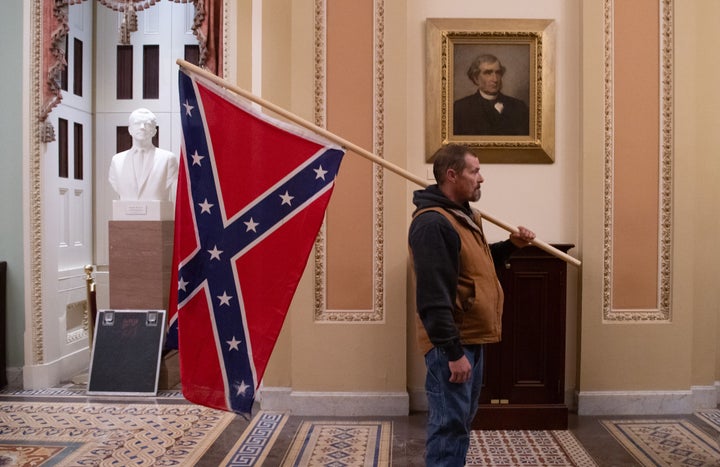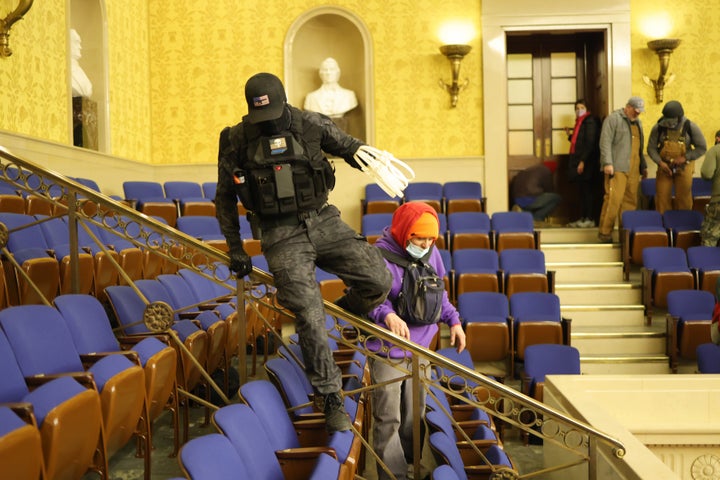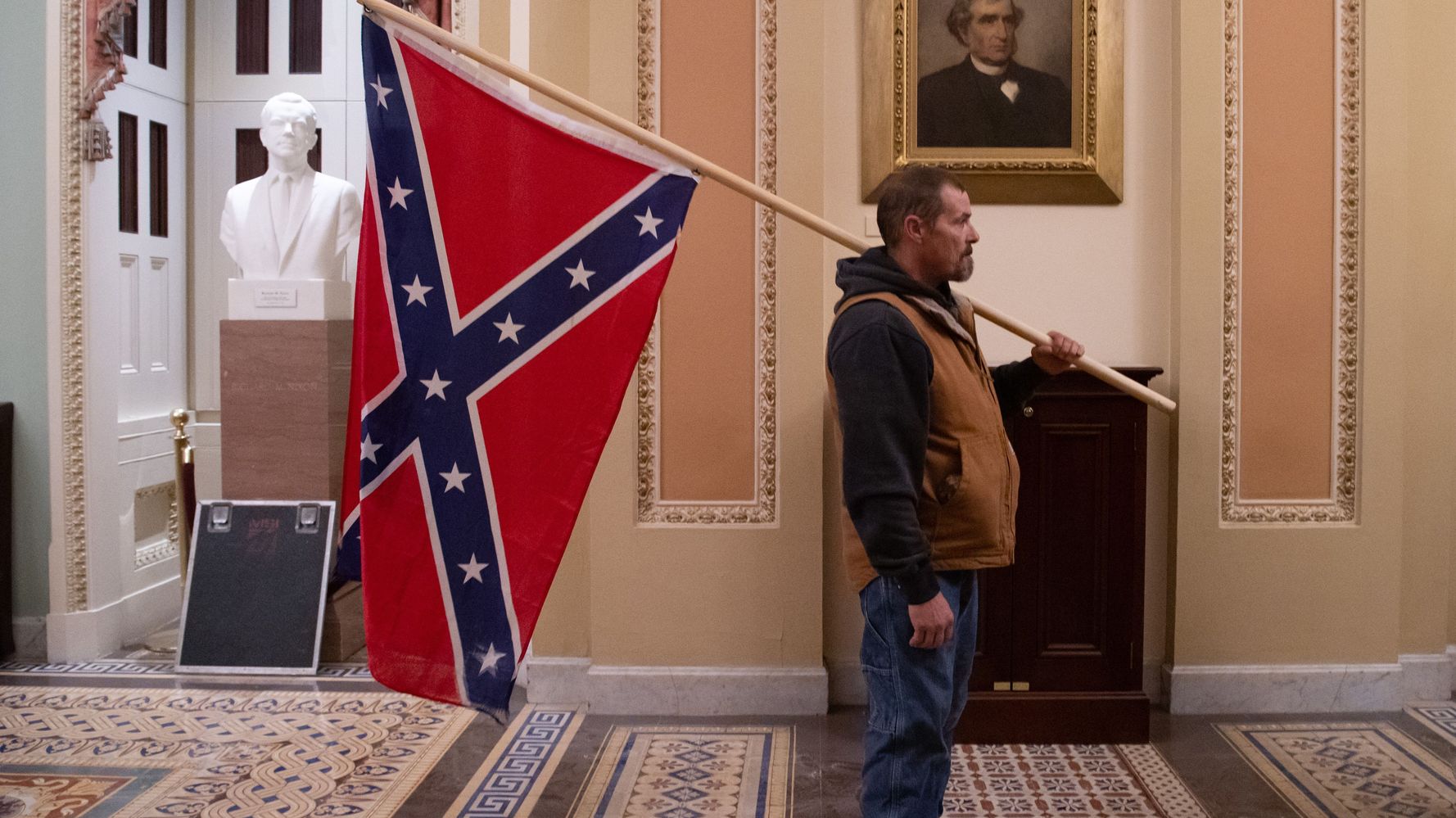[ad_1]
When a mob stormed the U.S. Capitol building on Jan. 6 in an attempt to overturn the presidential election, many of the rioters had family by their side.
Among those charged in the riot are a mother and son who recorded themselves in the Senate chamber; husband and wife QAnon believers who took a photo holding hands in the Capitol; a father and son on a birthday road trip; and numerous other siblings, relatives and spouses who stormed the Capitol together.
These families are part of what researchers call the “organized clusters†involved in the riot ― friends and families who were not necessarily part of extremist organizations but who still coordinated their actions in close-knit groups. These clusters make up about one-third of the people facing federal charges related to the insurrection, according to a report released on Tuesday from George Washington University’s Project on Extremism.
Rather than an homogenous mob moving with the same intent and fervor on Jan. 6, preliminary arrests and assessments of the rioters have shown that the crowd was made up of many different subsets. While far-right extremist groups such as the Proud Boys and Oath Keepers face some of the most serious charges and are alleged to have planned for potential violence, many smaller groups that include families with far-right beliefs appear to have spurred each other on to join in the insurrection.Â
“The initial data demonstrates the importance of involvement in friendship or kinship networks as a key factor in encouraging increasingly extreme beliefs and high-risk, often violent, activism,†GWU’s report states.

Supporters of then-President Donald Trump traveled with their families from across the country to Washington, D.C., planning their attendance at Trump’s “stop the steal†rally as if it were a trip to Disney World. In one case, Chance Uptmore and his father James Uptmore traveled from San Antonio, Texas, as part of Chance’s 5-day birthday trip. Chance, who confessed his involvement in the riot and implicated his father as authorities searched his home, posed for a smiling photograph as mobs stormed the Capitol. Both face charges of violent entry and disorderly conduct.
Another father and son, Kevin and Hunter Seefried, travelled to the Capitol together from Delaware. Kevin Seefried, who brought a large Confederate flag into the building, was widely photographed parading through the building. His son, Hunter, was later reported to the FBI after a coworker noticed him bragging about attending the riot, and prosecutors said footage showed Hunter Seefried breaking a window of the Capitol building as the mob forced their way inside.
Eric Munchel traveled from Tennessee to attend the rally — and, ultimately, storm the Capitol — with his mother, Lisa Eisenhart. Charging documents for the mother and son include photos of 30-year-old Munchel in tactical gear clambering over seats in the Senate chamber while holding flex cuffs and wearing a vest covered in far-right paraphernalia.
Munchel recorded much of their time in the Capitol building, including him calling out, “Wait! Mom, mom,†and, “Mom, where are you going, Mom? Focus,†as she wandered around. At one point, Munchel told his mother, “I want that fucking gavel†while the two walked around the Senate’s visitor gallery. Eisenhart told the British newspaper The Times afterward that she would “rather die a 57-year-old woman than live under oppression.†Both face numerous charges, including criminal conspiracy and violent entry. A separate mother and son duo from Iowa, Deborah Sandoval and Salvador Sandoval Jr., were also arrested last month.

Along with parents and children, siblings and spouses are also prominent among those arrested. Christina and Jason Gerding, a married couple from Illinois whose social media profiles include references to the QAnon conspiracy theory, posed for a photo holding hands inside the Capitol building while wearing matching Trump 2020 T-shirts. Christina Gerding allegedly posted the photo in a Facebook group, prompting another user to comment that they hoped she would be arrested.
“Since they let us inside, opened the door for us I think we’ll be just fine,†Gerding replied. She and her husband both face charges that include violent entry and disorderly conduct.
Researchers have extensively studied the connection between family relations and radicalization, often arguing that when someone in a family holds extreme beliefs, they can act as a mutual accelerant for others to become radicalized. Close-knit groups can function as echo chambers for extremist ideologies or motivate their members to take action.
Siblings and other family groups also often play prominent roles in organized terror groups and terror plots — the Boston Marathon bombing, the mass shooting at the Charlie Hebdo office, and the 2015 ISIS attack in Paris were carried out by brothers. Among the Oath Keepers militia members charged in relation to the Capitol siege were siblings and a married couple.
“If one among a close group becomes radicalized, that person has extra power to move the others ― family, friends, siblings,†said Clark McCauley, a research professor at Bryn Mawr College who has studied radical groups.
But family relations are not a unique factor driving violent actions like those on Jan. 6, McCauley argues. Being part of a cohesive group ― whether with family, friends or an organized militia ― can enable people to take violent actions that they may be incapable of carrying out alone.
“The way to think about the family relationships is that they are one type of cohesion-producing background, but not the only one,†McCauley said.  Â
The riot also showed how radicalization can divide relatives and social groups. Many people reported family and friends to the FBI after learning about their involvement. In one case, a teenager in Texas reported his father to authorities after the father threatened to shoot the family if they turned him in ― one of a slew of rioters with a connection to domestic violence. Other cases involved people reporting old acquaintances after seeing their Facebook posts celebrating involvement in the insurrection.Â
Some extremism researchers have pointed to the range of people who participated in the riot ― varying from white supremacist gangs to radicalized pro-Trump families and lone conspiracy theorists ― as proof that the American far-right is a broader movement capable of political violence.Â
Calling all HuffPost superfans!
Sign up for membership to become a founding member and help shape HuffPost’s next chapter
[ad_2]
Source link





